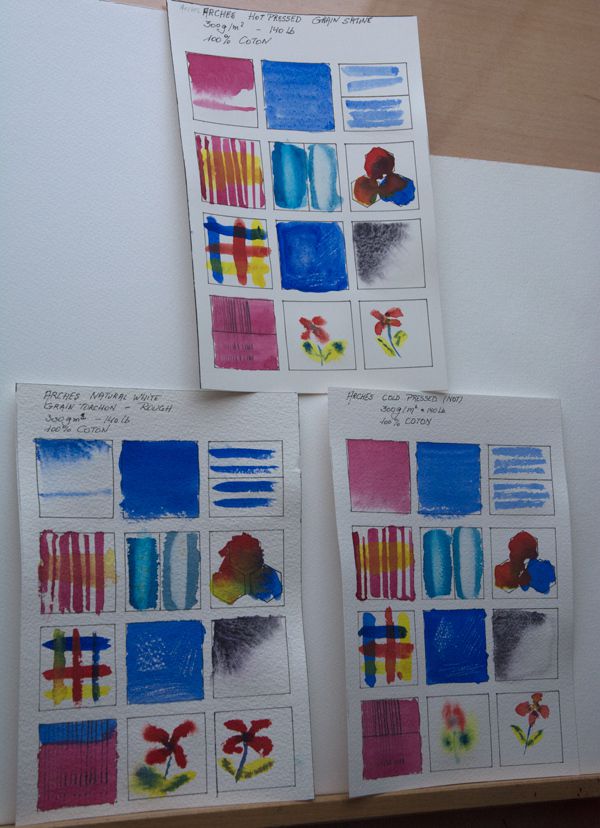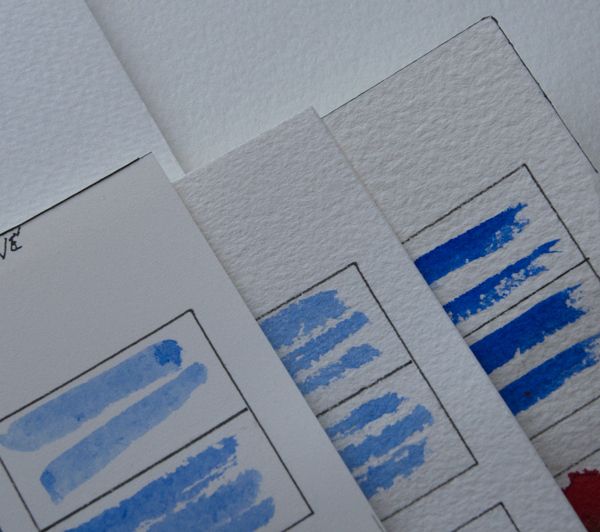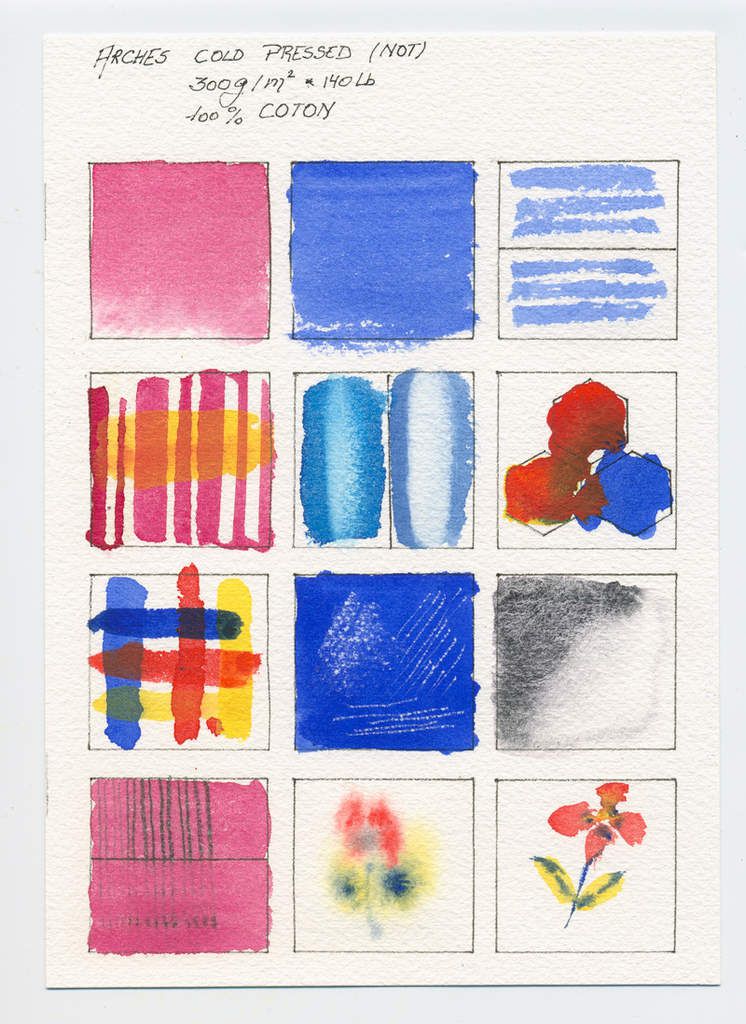Arches watercolour doesn’t need any presentation as it’s sold worldwide and used by amateur and professional watercolour painters. So the question rises … should i also use this paper or is there an alternative that suits my artwork ?
Some weeks ago, i started my research how to test and evaluate watercolour paper. I posted my questions in web workgroups and finale could make a standard test sheet. So my readers and myself can make a quite fine opinion on how a paper will react, which paper to chose for an artwork, and make pro and cons for every brand and surface tested.
I don’t have any relation with or interest in any fine art material manufacturer. I receive some samples but most of the tested products were paid by me, so that i can give an independent opinion and review.
When Canson launched its “Heritage” 100% Coton watercolour paper, the idea to make a big test was born. A new top quality watercolour paper, that claims to are better than Arches, is a real event in the watercolour world. But i needed a base for comparaison for all the tested papers and so i decided to do the first article and review on this Arches paper.
The Heritage paper test will be published within a couple of days. So you can start to compaire.
Please subscribe to my blog by putting you email in the box and you’ll receive a reminder when an new article will be posted.
Have a nice lecture and comparison and don’t hesitate to contact me if you have questions or remarks.
So off we go…


Arches Hot Pressed 300g / 140 Lb

General observation : The paper has a natural White color, with light warm undertone . Surface is very smooth. Paper curls and bubbles quite a lot, It curls in a cylindric form but bubbles also, the paper needs to be stretched if one uses water.
- Wet in Wet: The paint disperses well but very limited compared to other papers. You see quite well the small line, it dissolves only lightly. it’s quite rare that a hot pressed paper does absorb a lot of water, but this Arches does …
- Wet on Dry : We can see clearly marks left by the brush, as the paper absorbs a lot.I used a N°8 Escoda Kolinsky charged brush, but you can see that all paint was absorbed before the end of the painting area.
- Dry on Dry : There is a quite different behaviour of the dry and pre wetted area. The lines are different and the borders are more crisp. The treated paper has also a much rougher touch than the non watered area.
- Tape and Masking Fluid : The Schmincke masking fluid has damaged a little the paper. Edges of Sennelier masking fluid and the boards of the masking tape are very neat without any sign of damage.
- Lifting : Cerulean Blue lifting performs quite good but left some stain. The Phtalo blue area show very little lifting. I think as the paper does absorbs a lot of fluid, the stain goes quite deep in the paper and that’s why the staining is hard to lift.
- Mixing : As seen in the wet in wet section we can see here also the limited dispersion of the fluid so that colours doesn’t travel a lot and push each other without mixing.
- • Layering : Layering on this paper performs very well. There is very little mixing going on between the two layers. Although the second layer of yellow tends to mix a little with the red and blue edges.
- Scratching : Scratching with the flat side of the knife performs very well and reveals the light structure of the paper. Using the point of the x-acto knife forms fine traces but when one scratches a little harder, the paper is really damaged.
- Granulation : As mentionnes before, the dispersion is even but limited.The granulation is very nice creating like coton cloudy textures
- Erasing : The kneaded eraser doesn’t lift all the graphite as does the standard and electric eraser. The erased parts show a more intense colour than the not erased surface. Same constatation i did on the pre threatened area in the line painting (3)
- Painting on wet paper : The paint doesn’t travel and disperse as it normally does on a whetted surface.
- Painting on dry paper : The edges and strokes are very crisp and mixing is very limited
Conclusion : A very nice paper for very detailed work. Ink drawing does perform very well on this surface and erasing graphite lines aren’t a big problem, although that repainted erased surfaces does concentrate the pigment. There’s a lot of buckling going on so you have the choice to buy 4 sized glued blocks or the stretch you paper to avoid this.
PRICE
Sheet 56 x 76 cm - 22 x 30 in …. 5.40 £ - 5,45 $
Glued Blockxs 31 x 41 cm - 12 x 16 in …. 44.00 £ - 39.63 $
Arches Grain Cold Pressed - NOT 300g / 140 Lb

General observation : The paper has a natural White color, with light warm undertone . Surface has a slight marking texture . Paper curls and bubbles quite a lot, It curls in a cylindric form but bubbles also, the paper needs to be stretched if one uses water. That’s why many artists goes for 4 side glued blocks that doesn’t buckle and dries flat.
- Wet in Wet: The paint disperses well and smoothly. You can’t see the small line that has dissolves entirely. The Arches cold pressed paper does absorb a lot of water, this has his pro and cons, one can work longer before the water dries, but it marks and produces harder edges …
- Wet on Dry : We can see clearly marks left by the brush, as the paper absorbs a lot.I used a N°8 Escoda Kolinsky charged brush, but you can see that all paint was absorbed before the end of the painting area.
- Dry on Dry : There is a quite different behaviour of the dry and pre wetted area, but less than on hot pressed paper. The lines are different and the borders are more crisp on the non threaded surface. The treated paper has also a better paint flow than the non watered area.
- Tape and Masking Fluid : The Schmincke and Sennelier masking fluid and the boards of the masking tape are very neat without any sign of damage.
- Lifting : Cerulean Blue lifting performs very good but left a light stain. The Phtalo blue area show very little lifting. I think as the paper does absorbs a lot of fluid, the stain goes quite deep in the paper and that’s why the staining is hard to lift.
- Mixing : As seen in the wet in wet section we can see here also the limited dispersion of the fluid so that colours doesn’t travel a lot and push each other without mixing.
- Layering : Layering on this paper performs very well. There is very little mixing going on between the two layers. Although the second layer of yellow tends to mix a little with the red and blue edges.
- Scratching : Scratching with the flat side of the knife performs very well and reveals the light structure of the paper. Using the point of the x-acto knife forms fine traces but when one scratches a hard, the paper is slightly damaged.
- Granulation : As mentionnes before, the dispersion is even but limited.The granulation is very nice creating wrinkles and lines
- Erasing : The kneaded eraser doesn’t lift all the graphite as does the standard and electric eraser (but they live some traces). The erased parts, specially done with the Derwent and traditional eraser, show a more intense colour than the not erased surface. Same constatation i did on the pre threatened area in the line painting (3)
- Painting on wet paper : The paint doesn’t travel and disperse more limited than it normally does on a whetted surface.
- Painting on dry paper : The edges and strokes are very crisp and mixing and dispersion is limited
Conclusion :
This paper is the most used one by watercolour artists on the world. That’s why it the reference to compaire other papers.
This paper can be used for any painting style, but you need to preset it repeating the action several times if you don’t prepare your paper for stretching (needs at least 10 minutes of bathing in cold water before stretching ).
I don’t advice to use this paper non stretched as its curls and buckles, so if you don’t want the preparation i do advice to buy only 4 sides glued blocks.
PRICE
Sheet 56 x 76 cm - 22 x 30 in …. 5.40 £ - 5,45 $
Glued Blockxs 31 x 41 cm - 12 x 16 in …. 44.00 £ - 39.63 $
Arches Rough 300g / 140 Lb

General observation : The paper has a natural White color, with light warm undertone . Surface has a pronounced marking texture, but not as much as some handmade papers . Paper curls and bubbles quite a lot, It curls in a cylindric form but bubbles also, the paper needs to be stretched if one uses water. That’s why many artists goes for 4 side glued blocks that doesn’t buckle and dries flat.
- Wet in Wet: The paint disperses well and smoothly, but the flow is very limited. The gradual wash is really nice to perform on this paper but you’ll have to insists as the rough texture can modify density. You can’t see the small line that hasn’t dissolve at all. The Arches rough paper does absorb a lot of water, this has his pro and cons, one can work longer before the water dries, but it marks and produces harder edges …
- Wet on Dry : We can see marks left by the brush, as the paper absorbs a lot. I used a N°8 Escoda Kolinsky charged brush, but you can see that all paint was absorbed before the end of the painting area.
- Dry on Dry : There is a quite different behaviour of the dry and pre wetted area, but less than on hot pressed paper. The lines are different and the borders are more crisp on the non threaded surface. The treated paper has also a much equal flow than the non watered area.
- Tape and Masking Fluid : The Schmincke and Sennelier masking fluid and the boards of the masking tape are very neat without any sign of damage.
- Lifting : Cerulean Blue lifting performs very good but left a light stain. The Phtalo blue area show little lifting (better than on the two other surfaces). I think as the paper does absorbs a lot of fluid, the stain goes quite deep in the paper and that’s why the staining is hard to lift.
- Mixing : As seen in the wet in wet section we can see here also the limited dispersion of the fluid so that colours doesn’t travel a lot and push each other without mixing.
- Layering : Layering on this paper performs very well. There is very little mixing going on between the two layers. Although the second layer of yellow tends to mix a little with the blue edges.
- Scratching : Scratching with the flat side of the knife performs very well and reveals the structure of the paper. Using the point of the x-acto knife forms fine traces but when one scratches a hard, the paper is slightly damaged but resist quite fine. As i don’t use this technique very much, one has to test on painting on it after scratching.
- Granulation : As mentionnes before, the dispersion is even but limited.The granulation is very nice creating nice textures of wrinkles and lines
- Erasing : The kneaded eraser doesn’t lift all the graphite as does the standard and electric eraser (but they live some traces). The erased parts, specially done with the Derwent and traditional eraser, show a more intense colour than the not erased surface. Same constatation i did on the pre threatened area in the line painting (3)
- Painting on wet paper : The paint doesn’t travel and disperse more limited than it normally does on a whetted surface.
- Painting on dry paper : The edges and strokes are very crisp and mixing and dispersion is limited
Conclusion :
This paper is a more technical paper, that is very useful to create textures, but isn’t ideal for detailed art. It’s used most by landscape painters, for mixed media and texture oriented watercolour art.
This paper can be used for any painting style, but you need to preset it repeating the action several times if you don’t prepare your paper for stretching (needs at least 10 minutes of bathing in cold water before stretching ).
I don’t advice to use this paper non stretched as its curls and buckles, so if you don’t want the preparation i do advice to buy only 4 sides glued blocks.
I tested first these Arches papers as this makes is a base for comparison with the other brands for which i did the test sheet paintings. I’ll post in the next days my observations and comparaisons with the Canson Heritage, Moulin du Roy and Lanaquarelle papers.
Special thanks to Denis Beaux Arts for the free samples that i received from them. This french webstore sends worldwide you can visit their site using this link.
You can find full information on the Arches web site
You can buy Arches Papers using these links :

Aucun commentaire:
Enregistrer un commentaire